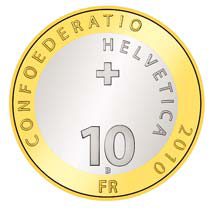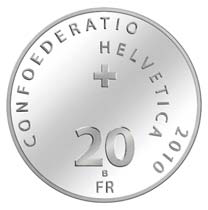Content
New commemorative coins


In January, two new commemorative coins were issued. This year's bimetallic 10 francs coin depicts an alpine marmot. It is the fourth and last coin in the "Swiss National Park" series (with an ibex in 2007, a golden eagle in 2008 and a red deer in 2009)


The subject of the silver 20 francs coin is the Bernina Railway. It continues the "Swiss Railways" series, which has begun with the issues "Vitznau-Rigi Railway" in 2008 and "Brienz-Rothorn Railway" in 2009. The Bernina Railway connects St. Moritz with Tirano in Italy. The line opened in 1910. It started as an independend company, but was taken over by the Rhaetian Railway in 1944. In 2008, the Bernina Railway, together with the Albula Railway, was declared a UNESCO World Heritage Site.
For June 2010, two more commemorative coins are announced. A silver 20 francs issue will commemorate the 100th anniversary of the death of Henry Dunant, Peace Nobel Prize winner and founder of the International Committee of the Red Cross. A golden 50 francs coin will honor the painter Albert Anker who, like Dunant, died in 1910.
For a full list of Swiss commemorative coins, refer to the Wikipedia article Gedenkmünzen der Schweiz.
New circulating coins
As of now, the 2010 issues of Swiss circulating coins are only available in mint sets. They will be put in cirulation as soon as soon as the remainder of the previous years has been used up. The dates that currently enter circulation are 2008 for the 5 Fr. coin and 2009 for all other denominations.
For some reason unknown to me, the demand for new coins is unusually high at the moment. In circulation, a large percentage of new dates can be found, and the Swiss mint had to produce coins in much larger quantities than in previous years. The mintage figures for the current year have already been fixed and they are given here together with the figures for the previous year.
| 2009 | 2010 | |
|---|---|---|
| 5 ct. | 45'000'000 | 44'000'000 |
| 10 ct. | 35'000'000 | 42'000'000 |
| 20 ct. | 32'000'000 | 18'000'000 |
| 1/2 Fr. | 27'000'000 | 27'000'000 |
| 1 Fr. | 11'000'000 | 15'000'000 |
| 2 Fr. | 8'000'000 | 9'000'000 |
| 5 Fr. | 2'000'000 | 5'000'000 |
Swiss coin trivia
You probably already now that 1/2 Fr. 1968/1969, 1 Fr. 1968 and 2 Fr. 1968 exist both with and without the mint mark "B". Catalogs usually state that the coins with a "B" were minted in Bern and those without mint mark in London (and those from 1970 to 1985 in Bern, although they bear no mint mark). But the catalogs only tell half the truth. And the Krause catalog confuses things even more by stating that "All coins minted [in Bern] carry a B mint mark through 1969, except for the 2-Centime and 2-Franc values where the mint mark was discontinued after 1968." This is plainly wrong, since all 2 francs dated 1969 do carry the mint mark "B", and the 2 centimes dated 1969 were minted in London, as the missing mint mark suggests. So, does this mean that the rule "B = Bern, no mm = London 1968/69 and Bern 1970-85" holds? Well, almost, but not entirely. There are two exceptions: 1/2 franc 1970 (no mint mark) were minted both in Bern and in London. And 1 franc 1969, too, were struck in both mints, although all coins have a "B" on them. No catalog that I know of states these facts correctly. And I wouldn't have known about it if it weren't for the research of numismaticist Ruedi Kunzmann. If you are interested in the details of his reasearch, here's the publication:
Ruedi Kunzmann: "Die Silbermünzenkrise der Schweiz von 1968 und die Tätigkeit der Royal Mint, London". In: Schweizer Münzblätter. Vol. 50, Nº 200, 2000, ISSN 0016-5565, p. 68-72.
This is the first issue of my newsletter about Swiss coins. A new one will be published about twice a year. If you wish to be notified about new issues by e-mail, simply tell me so by writing to  and I will put you on the mailing list.
and I will put you on the mailing list.
![]() Swiss coins
Swiss coins
This is a subpage of Marcel's Coin Collection and
Marcel's Collections.
Last update: Feb 3 2010